Buy a portable analog multimeter online, it features a rugged construction that ensures long-lasting durability. Its analog display provides clear and immediate readings, ensuring precision and accuracy every time.
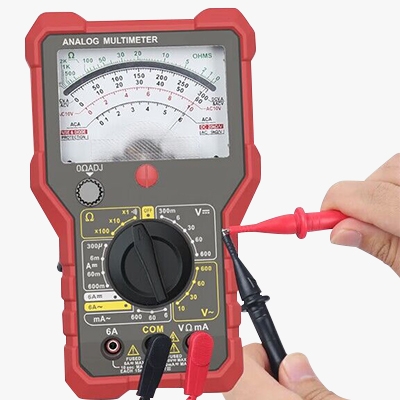
Current/Voltage Measurement
- The analog multimeter can measure both alternating current (AC) and direct current (DC).
- SISCO analog multi meter supports measurement of both AC and DC voltage.
- The portable analog multimeter tester is capable of measuring electrical resistance.
- This analog type multimeter includes a function for measuring sound levels in decibels.
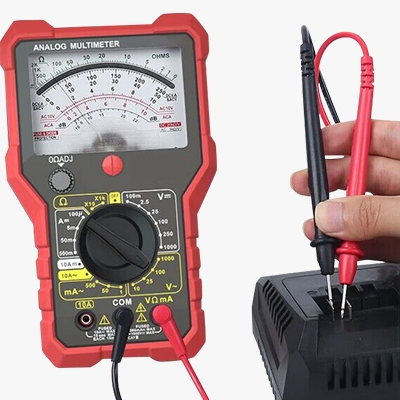
Handheld Design with Rotatable Support Stand
- The portable analog multimeter can perform continuity tests to check if a circuit is complete.
- The back of the pointer multimeter is designed to easily store the probes.
- It features an adjustable stand, allowing you to set the multimeter at a convenient viewing angle during use.
- The outer casing is comfortable to hold and provides excellent shock resistance.
Applications
SISCO analog multimeter is a versatile tool used in various applications, including electronics repair, electrical maintenance, car repair and laboratory testing. It measures voltage, current, and resistance, and often includes additional features such as capacitance, frequency, and temperature measurement. Its precision and multifunctionality make it essential for diagnosing and troubleshooting electrical issues in both professional and educational settings.

Car Repair
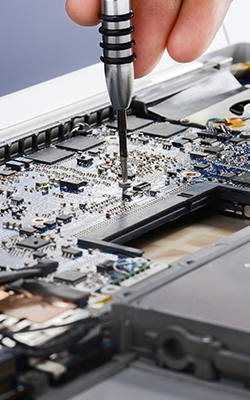
Electronics Repair

Laboratory Testing

Electrical Maintenance
| Model | SISCO-AM-DEM43 | Accuracy Level |
| DC Voltage (Sensitivity: 20kΩ/V) | 100mV/2.5V/25V/100V/250V/1000V | Level 3 |
| AC Voltage (Sensitivity: 9kΩ/V) | 10V/25V/100V/1000V | Level 4 |
| DC Current | 100μA/5mA/50mA/500mA/10A | Level 3 |
| AC Current | 1mA/50mA/500mA/10A | Level 5 |
| Resistance | x10 range: 2-~20kΩ, scale center is 2000Ω | Calculated based on 3% of the scale working arc length |
| x1K range: 200~2MQ, scale center is 20kΩ | ||
| AC Frequency | 50Hz~400Hz | |
| Decibel | -10~22dB/30dB/B2042dB/62dB | |
| Continuity Test | X | |
| Dimension | 179*108*58mm | |
| Weight | About 402g (including battery) | |
Dimension
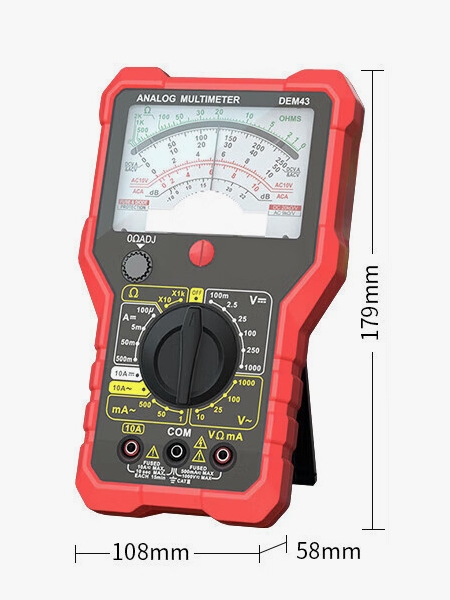
Details
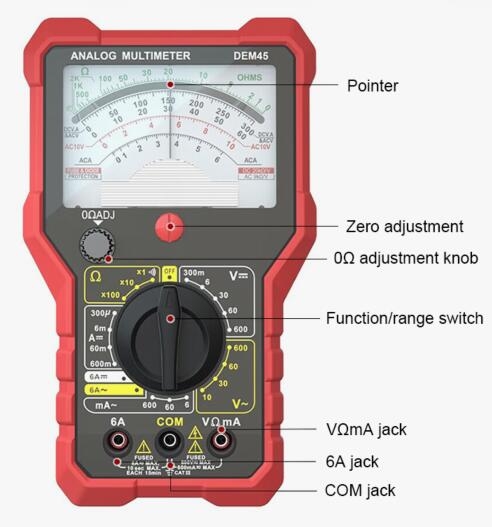
Q1: What is an analog multimeter?
A1: An analog multimeter is a type of electrical measuring instrument that displays readings via a moving needle over a graduated scale. It is used to measure various electrical parameters such as voltage, current, and resistance in circuits, and it operates on the principle of a moving coil galvanometer.
Compared to digital multimeters, analog multimeters are valued for their ability to show continuous variations in readings, making them particularly useful for observing fluctuations in measurements. However, they are generally considered less accurate and harder to read due to the parallax error and the need for manual range selection.
Q2: How do I zero the analog multimeter for resistance measurements?
A2: To zero an analog multimeter for resistance measurements, first set the multimeter to the lowest resistance range. Touch the two probes together to create a short circuit. Adjust the zero-ohm calibration dial, usually located near the dial or on the side of the meter, until the needle points to zero on the resistance scale. This ensures accurate readings by accounting for any internal resistance in the probes and meter.
Q3: What should I do if the needle doesn't move when taking a measurement?
A3: If the needle doesn't move, check the following:
- Connections: Ensure the probes are securely connected to the multimeter and making good contact with the test points.
- Range Setting: Verify that the range setting is appropriate for the expected measurement. If the range is too high, the needle might not deflect enough to be noticeable.
- Multimeter Functionality: Test the multimeter with a known voltage or resistance to confirm it is functioning correctly. If it still doesn’t move, the meter or the probes may be faulty and need repair or replacement.
Tips: How to use a SISCO analog multimeter to measure decibels?
Measuring decibels with an analog multimeter is similar to measuring AC voltage, except you use the "dB" scale (i.e., scale "E") when reading the values.
For measurements in the AC 10V range, directly read the value from the "dB" scale. If the reading exceeds +22dB, switch to the 25V, 100V, or 1000V range, and then add a certain value to the reading from the "dB" scale according to the instructions below. The resulting value is the final measurement result.
Thank you for buying industrial test and measurement equipment on SISCO.com, all products sold by SISCO and the partner cover a 12 months warranty, effective from the date of receiving the products.
What is covered?
SISCO is responsible for providing free spare parts, and free technical support to assist the customer to repair the defective products until the problem is solved.
What is not covered?
- Product purchased from anyone other than a SISCO store or a SISCO authorized reseller.
- Expendable parts.
- Routine cleaning or normal cosmetic and mechanical wear.
- Damage from misuse, abuse or neglect.
- Damage from use of parts other than SISCO approved.
- Damage from use outside the product’s usage or storage parameters.
- Damage from use of parts not sold by SISCO.
- Damage from modification or incorporation into other products.
- Damage from repair or replacement of warranted parts by a service provider other than a SISCO authorized service provider.
- Damage caused by the application environment not meeting the product usage requirements and the failure to perform preventive maintenance.

